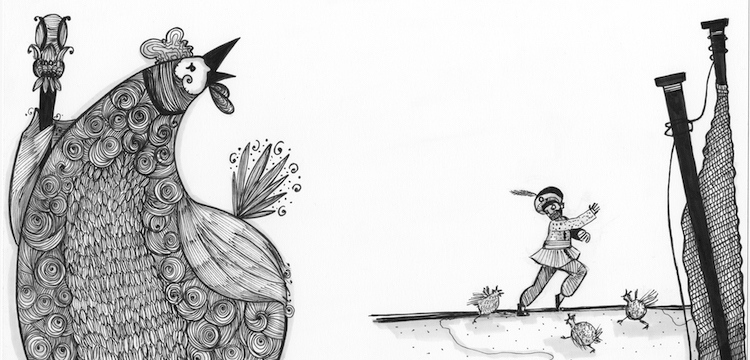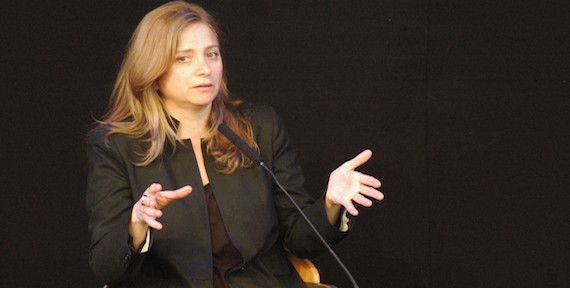[Editor’s note: This article is part of Al-Jumhuriya’s “Gender, Sexuality, and Power” series. It was also published in Arabic on 29 November, 2018.]
Whether we take language to be an invisible, faithful scribe of reality, and of the collective symbolic and psychological system of any given meeting of humans, or whether it manufactures its own social reality subsequently; that’s to say, whether we suppose the precedence of language over reality, or that of reality over language, in either case nothing could be more legitimate than to question the relationship between language and sexuality, in the social sense, and what any given language reflects in this regard. How does a given language conceal gender and sexuality, or bring them out; how does it treat them; how does it do justice to one and discriminate against another? And how does language keep up with such rapid global changes as those found in gender theory? May we say, of any given language, that it is structurally male-chauvinist? And, if so, is there a possibility of dismantling that chauvinism?
When considering language and sexuality, and their relationship to one another, often a certain general conjecture tends to blend two levels of approach that are not necessarily similar. The first is language as a system; old, formal, and grammatical; offering no opportunity for synchronic comprehension. The second is language as performance, deeply-rooted and contingent on meeting; political and psychological. In simpler terms, when people say things like, “the Arabic language is chauvinist and misogynist, because the feminine form of nā’ib (“member of parliament”) is nā’iba, and nā’iba also means “disaster,” they add nothing to the critique or dismantling of the language’s chauvinism, or, to put it more boldly, its phallicism. For, quite apart from the fact that the saying is laughable, and linguistically inexact, the word nā’iba long predates the parliamentary system, and homophony exists in all languages. Its unfortunate accidents are hardly limited to that one example, or to Arabic. Moreover, if we’re truly to give feminization a significance beyond the merely grammatical—that’s to say, a semiotic significance tied to reality—then we’ll be astonished at the extent of its importance in Arabic, and its inconsistency in its grammatical and morphological functions, for feminization can convey diminution (either affectionate or derogatory), as is well-known, but it may equally convey aggrandizement or the conferment of value: compare rijāl (“men”) and rijālāt (“great men”), or buyūt (“houses”) and buyūtāt (“grand houses”).
This pure grammatical aspect of the subject of feminization may be studied as part of all the components of language, starting with the inflection that makes words feminine or masculine, and why, or the grammar that makes the Arabic language, like many others, conjugate groups of males and females as a group of males, or which pluralizes all non-human objects and animals as feminine singulars. There is nothing pertinent in that approach, except from a purely activist perspective, aspiring to force language to emphasize (rather than conceal) other sexualities, as in the approach that adopts inclusive spelling in Western languages, and sometimes in Arabic; for example, when masculine and feminine are pluralized with the same word. There is nothing pertinent, at least in our present time, in attempting to study the elasticity of language with sexualities in such an approach as this. This is not to negate that the most modern linguistic studies currently attempt to tie grammatical characteristics with historical social and pragmatic
In this technical, grammatical discussion, there is one aspect that may be of great significance at the socio-political level, which is the lexical one. What are the “signifiers” used to express the sexual “signifieds” and lived experiences? It may be useful here to compare between languages. For example, while the gender inflection is limited to the masculine/feminine dichotomy in most of the Mediterranean languages we know, the Native American Quechuan languages use five gender inflections. Within male and female in the biological sense, there are many variations depending on the person’s mood, and nature, and sexual inclinations; all these overlapping with the biological gender. To take another example, it would be intriguing to know when the use of homophobic terms equivalent to “gay” and “queer” ceased in other languages and cultures. Are the new lived experiences and sexualities able to find a new vocabulary? Are women and queer spaces capable of creating new terms? This is important, because the very act of naming in itself is significant. To name is to obtain power, close to the performative power in the act of baptism. In this sense, the origination of vocabulary is a political act and event. Are the actors in these spaces independent of international actors—such as non-governmental organizations and others—when carrying out this act of naming? Is it necessary for them to be independent in their local cultural spaces, or is the universalist struggle (as opposed to the culturalist one) a unified struggle? If so, is the signification of concepts and lived experiences unified and universalist? Is our use of the terms ghayrī (“hetero”) and mithlī (“homo”) as direct equivalents of the Latin lexicon a form of linguistic subordination to a certain centralism? Is the matter superfluous; the naming irrelevant? These questions are worth posing and answering, and they are cognitive questions, unlike the ideological one about nā’iba and nā’ibāt mentioned above.
Language in the social, symbolic, and political senses
As for the other level that may be usefully examined in language, and how it reflects social and sexual reality, it is pragmatics, and sociolinguistics; that is, the particularities of language spoken by different social types, and what these say of place, power, lived experience, and relationship with or subordination to the other sex. Linguists, paradoxically, have worked little on gender. The first attempt at such an approach was problematic, because it led to an essentialist position, in that it was an attempt to characterize the speech and language of women as though these were fixed and settled phenomena unsusceptible to change over time, without any mention of socialization and historical political determinants. The late Danish linguist Otto Jespersen was the first to address this, in 1922, when he spoke of the language of women being closer to the central core of language; taking no risks; nor roaming imaginatively; nor approaching the exotic except in rare cases; in other words, being uncreative. Then came the American sociolinguist William Labov, who wrote of the diversity of registers of speech, including those of women’s language. In a celebrated study of New York’s Harlem neighborhood, he observed that women’s language avoided marginal features such as obscenity, or linguistic corruptions, or slang, or the vocal variations adopted by rebellious youths, and so on.
Of course, this is an example from the international literature, but the observations remain pertinent in the Arab context. In a study I recently read about the sound of the letter qāf in Palestine
Later, there came other linguists who analyzed the characteristics of women’s speech from another perspective; that of authority, and power balances, and legitimacy. The most famous of these is Robin Lakoff, an American linguist who began as a grammarian and then turned to sociolinguistics, working from a pragmatic and analytical perspective on conversations and linguistic exchanges, and writing also of certain characteristics of women’s speech related to the nature of their status and authority in society. For example, the interruptions during speech encountered often by women; and their use of softened, uncertain wording, avoiding affirmation; and their use of exaggerated, meaningless words; and mollifying questions; all of these occur because men don’t respond to their questions, whereas they do feel obliged to reply to other men’s questions. These observations also apply to language used by sexual minorities seeking legitimacy.
If we regard these matters as linguistic “habitus” embedded in women’s behavior—virtual inevitabilities that cannot be changed due to archaic patriarchal systems—then what’s the point of bringing them up? Can they be altered? At least, as concerns interruption during speech, there is a battle at hand, a political and educational one. I still recall the media debates in France when the law was issued prohibiting the hijab and other religious symbols in schools between 2003 and 2004. Veiled women were invited to take part in the televised public discussions, and yet were not allowed to finish a single sentence. In other contexts, a group of well-mannered men might take care not to interrupt their female counterparts, but when the conversation heats up politically or intellectually, and emotions run high, it’s inescapable that the men will band together, forgetting the women, looking only at one another in a mutual mental enthrallment from which women are excluded, no longer listening to anyone but themselves. Within all this, there are overlapping and interlocking social and class-based codes and symbols. The class code remains present and alight, overseeing the course of the conversation in spite of the sea of chauvinist ardor. Men will always continue to give time on occasion to women of wealth or influence.
Speech as a scepter in women’s hands
Certain events that came and went rapidly amid the recent ongoings in Syria deserve further consideration. When one well-known Syrian woman activist passed away in the summer of 2017 in her Parisian exile, one of the most prominent eulogies offered by the hangmen of the “opposition to the opposition” concerned her resort to silence after leaving Syria. Naturally, silence is required of everyone, for it’s the sole form of legitimacy permitted in the Syrian grinding mill, and there is no room for mistakes or miscalculations at the level of discourse, whether it’s men or women seeking to speak. What is noteworthy in this woman’s case, however, is the identification of silence with a kind of purity or preserved dignity, in the sense that the activist had not been sullied with Syrian blood, and perhaps (or probably) not with any other kind of pollutant in this hangman’s imagination, the strongest evidence of her cleanliness being her silence. At many other times, when a woman speaks with eloquence and precision and cognitive command, the automatic first reaction (which I’ve noticed personally on social media) is incomprehension, conscious or unconscious, in the sense that large words coming out of a woman’s mouth are necessarily inscrutable, lacking clarity, and usually pretentious and specious. A woman who can talk is a pseudo-intellectual, not an intellectual. When I was applying the final touches to this essay—which is a somewhat “dry” essay, even if it’s not an in-depth academic text so much as one introducing and identifying linguistic sensitivities in the field of power—all kinds of questions governed the last look at the writing. Is it clear? If not, then I lack command of my knowledge. Is it simple enough? If it’s not accessible, I’ll be accused of sophistry. In exchanges and conversations, there are more polite and spontaneous (not to say chauvinist) responses that can be examined. Big words from a woman’s mouth are met with the astonishment of seeing a circus seal playing expertly with a ball; astonishment mixed with fear of the inevitable slip-up, for mistakes are unavoidable in animals whose behavior is unrestrained. We see that fear in the (male) listener’s imitation of the woman’s words, as is done when children first begin talking, when we speak with them soundlessly to confirm they’re saying the right thing, raising our eyebrows in innocent amazement.
In more complicated cases, such as that of the Arabic language, which exists in two distinct forms—classical (fuṣḥā) and colloquial (Ꜥāmmīya); one of authority, one of intimacy—it is difficult for a woman to be convincing in the former. Should she succeed, she loses her femininity as a result. It was very telling, in this context, to observe Syrian social media following the gathering of the Qubaysiat women’s association
I never tire of repeating an observation dear to my heart on this point, made by one linguist in a study of the stories of Hans Christian Andersen and the Brothers Grimm and other children’s fairytales that are now universal, familiar to my generation as a global inheritance. In the tales, women achieve success by means of silence and forbearance; their achievements are never the result of speech. Comparing Andersen’s story The Wild Swans and the Grimms’ Brave Little Tailor, we find that the young tailor achieves his objective merely by uttering seven words and placing his hand on his belt, whereas the princess whose brothers were turned into swans by a magic curse had to weave shirts from stinging fabric found only in graves, and take a vow of silence for seven years. Changing and taking control of destinies by means of speech is denied to women, because speech is illegitimate for them, unless it passes through men, or if the women obtain legitimacy through their deterministic or economic or hereditary control over the fates of other men. Needless to say, women’s essential illegitimacy intertwines here with the illegitimacy of the authority of the poor or economically disenfranchised. In our countries, it’s become well-known that the women-elderly-poor triumvirate is rock-bottom in social power terms. Virtue in women is associated with the characteristics of forbearance and patient endurance, whereas emotional outbursts are closer to masculinity, which is why scholarly women are described as “hard-working,”“perseverant,” and “studious,” while men are more likely to be called “intelligent,” “brilliant,” and “genius.” Patience inspires trust in a woman; we’re apprehensive of her momentary outbursts, which summon images of feminine hysteria with unpredictable results. This is all conveyed most clearly in language.
Despite my determination to avoid exhortations, especially political ones, and my understanding that the complexities of society and reality will not be changed by wishful thinking and passing activist impulses, I nonetheless believe that among the most important things that can be done in the linguistic feminist struggle is to try to encourage the involvement of women in breaching and transgressing the linguistic performative authorities. Transgression here means approaching and taking possession of the performative authorities, without this seeming like a sarcastic or parodical imitation. It means impelling women to take up religious leadership and jurisdiction; and secular judicature; and writing and narrating history in the colloquial Arabic language that’s supposed to stay confined to the household; and irony and black humor; and police literature; and everything else that it never occurs to nā’ibāt to undertake. It means women scorning the recommendation of the old poet al-Farazdaq to slaughter the chickens that dare to crow like roosters, and them crowing poetry and desires and texts that give voice to bodies that internalise the meaning of power and repression in full.








